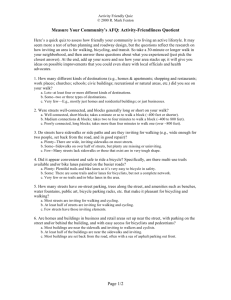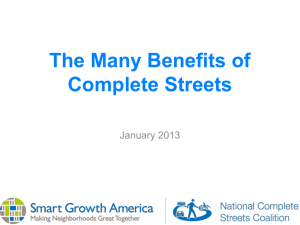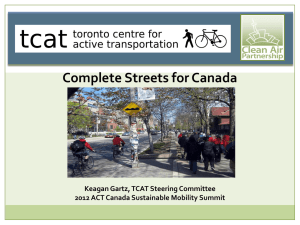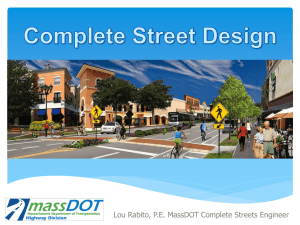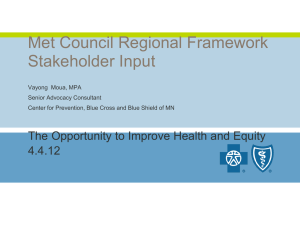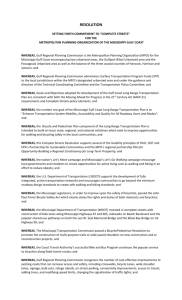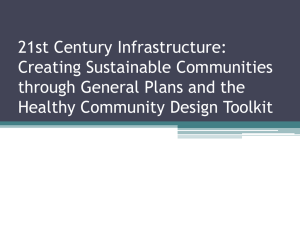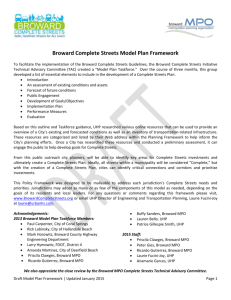The Many Benefits of Complete Streets
advertisement
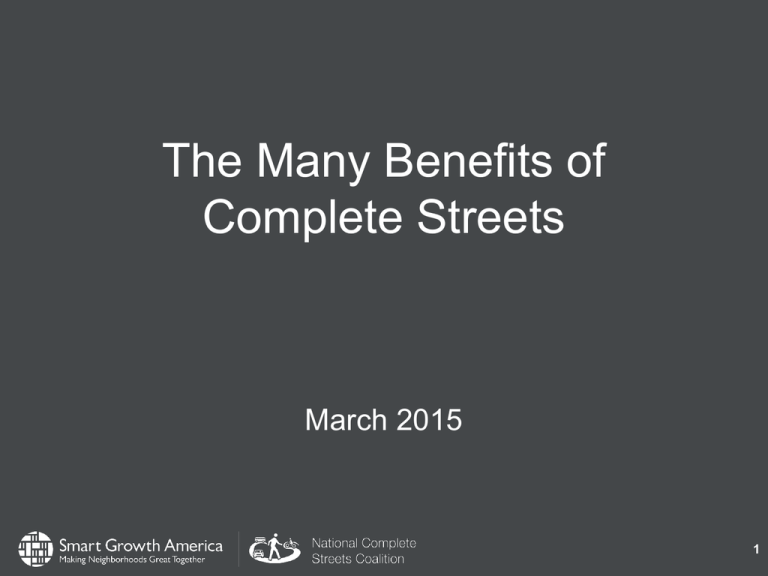
The Many Benefits of Complete Streets March 2015 1 What are Complete Streets? Complete Streets are streets for everyone, no matter who they are or how they travel. 2 What are Complete Streets? Safe Comfortable Convenient 3 What are Complete Streets? Safe Comfortable Convenient 4 Complete Streets benefit all users 5 Complete Streets policies Ensure that the entire right-of-way is planned, designed, constructed, operated, and maintained to provide safe access for all users 6 Benefits: Older Adults By 2025, nearly 1 in 5 Americans will be 65 or older. About ½ of all nondrivers over the age of 65 would like to get out more often. 7 Benefits: Older Adults Complete Streets = better design for older folks driving and walking. Complete Streets = staying active and involved in communities. 8 Benefits: Children More than 1/3 of kids and teens are overweight or obese. Unhealthy weight gain brings higher risk for pre-diabetes, high cholesterol, high blood pressure, sleep apnea, and joint problems. 9 Benefits: Children Dedicated, safe spaces for bicycling and walking help kids be active and gain independence. Being physically active helps kids learn and improves their mental health 10 Benefits: Children In a five-state study, infrastructure improvements and promotional programs increased walking by 45% In New York City, areas with Safe Routes to School programs had a 44% lower pedestrian injury rate in 5 to 19 year olds. 11 Benefits: People with Disabilities Almost 1 in 5 Americans have some type of disability. Complete Streets = attention to detail for travelers with disabilities. Complete Streets can reduce isolation and dependence. 12 Benefits: Transit Connect transit to work, to shops, to schools, to homes through appropriate planning and design for transit users. Create smooth, predictable transit trips by planning and designing for transit vehicles. 13 Benefits: Transit Complete Streets = easier to take transit. 14 Streets can benefit communities Improve safety Better health Stronger economies Reduce costs Provide choices Smarter growth 15 Benefits: Safety There were 32,719 traffic fatalities in the U.S. in 2013. Of these fatalities: 21,132 were people in cars 4,735 were people walking 743 were people on bicycles National Highway Traffic Safety Administration: Fatality Analysis Reporting System 2010 16 Benefits: Safety More than 40% of pedestrian fatalities occur where there is no available crosswalk. 17 Benefits: Safety Slower speeds = improved safety W.A. Leaf and D.F. Preusser, “Literature Review on Vehicle Travel Speeds and Pedestrian Injuries Among Selected Racial/Ethnic Groups,” US Department of Transportation, National Highway Traffic Safety Administration (1999). 18 Benefits: Safety Pedestrian crashes 88% with sidewalks 69% with hybrid beacon 39% with medians 29% with road conversions 19 Benefits: Health Risk of obesity: Increases 6% for each hours spent in a car. Decreases 4.8% for each additional kilometer walked. Frank, L., et. al. (2004). Obesity Relationships with Community Design, Physical Activity, and Time Spent in Cars. American Journal of Preventative Medicine 27(2). 20 Benefits: Health States with the lowest levels of biking and walking have, on average, the highest rates of obesity, diabetes, and high blood pressure. 21 Benefits: Health The Centers for Disease Control and Prevention recommend adoption of Complete Streets policies as a strategy to prevent obesity. 22 Benefits: Health Women who walk or bike 30 minutes a day have a lower risk of breast cancer. A 30-minute round-trip bicycle commute is associated with better mental health in men. People who live in walkable neighborhoods get more exercise than those who do not. 23 Benefits: Health One third of regular transit users meet the minimum daily requirement for physical activity during their commute. 24 Benefits: Economy Washington, DC: Barracks Row/8th Street SE $8 milllion public investment in streetscape improvements 2003-2004 $8 million in private investment in following two years 32 new business establishments $80,000 in sales tax annually 25 Benefits: Economy Lancaster, California: • Reconstruction • Changed signal timing • Added landscape • Created center “rambla” area • $10 million public investment 26 Benefits: Economy Lancaster, California: • Reduced speeding • Fewer crashes • 50 new businesses • 800 new jobs • Vacancy rate: just 4% • Sales tax revenue: up 26% 27 Benefits: Economy After 2007 redesign: 49% in retail sales on 9th Ave in Manhattan. 49% in commercial vacancies in Union Square. 28 Benefits: Economy 29 Benefits: Job Creation Under the 2009 stimulus: Transit projects = 71% more jobs per dollar than road projects. Every $1 billion spent on highway projects = 2.4 million job hours transit projects = 4.2 million job hours 30 Benefits: Job Creation For each $1 million invested: • Bicycle projects = 11.4 jobs created • Pedestrian projects = 9.6 jobs created • Auto-only project = 7.8 jobs created 31 Benefits: Economy In most metro areas, every +1 point on the Walk Score scale = of $500-$3,000 in home value. Walkable commercial neighborhoods in Washington, D.C. have 75% higher office rents than drivable, suburban neighborhoods. 32 Benefits: Economy Millennials want to work in areas with high quality transportation and high quality of life. Businesses that encourage active transportation attract young professionals and better business. 33 Benefits: Economy “Young people do not want to work in office parks anymore… We’re seeing this big change in this country. It’s not political…it’s more generational… This is where we need to think very differently, because if you don’t, you will be left behind.” -Mitchell Silver, Former Chief Planner, Raleigh, N.C. 34 Benefits: Economy “Our employees are healthier, happier, and more productive. We’re attracting some of the best talent in the industry. And, most important, we’re attracting new and exciting clients to fuel the bottom line.” –Christine Fruechte, President and CEO, Cole + McVoy 35 Benefits: Reduce Costs “The advantage of inserting a dialogue about all users at the earliest stages of project development is that it provides the designers and engineers the best opportunity to create solutions at the best price.” - James Simpson, Former Commissioner, NJDOT 36 Benefits: Reduce Costs 500 miles of Washington state highway system are ‘main streets.’ Over ten years, 47% of projects on these streets had scope, schedule, or budget changes resulting in delay. 37 Benefits: Reduce Costs Pilot project consulted community during planning, resulted in Complete Streets approach. In 10 previous years, a Complete Streets process would have saved an average of $9 million per Main Street project – about 30% – in reduced scope, schedule, and budget changes. http://www.wsdot.wa.gov/research/reports/fullreports/733.1.pdf 38 Benefits: Reduce Costs Lee County, Florida • Re-examined 5 road-widening projects • Found widenings unnecessary • = $58.5 million savings 39 Benefits: Reduce Costs Richfield, Minnesota road needed replacement after sewer work. Priced at $6 million to replace road as is. MnDOT re-evaluated transportation needs and found no need for wide roadway. Reallocated road space for all users, saved $2 million “Feels like home” 40 Benefits: Capacity 41 Benefits: Provide Choices Improvements in 4 communities over 4 years • = 22% in walking overall • = 49% in bicycling overall • = 23.1% in utilitarian trips made by foot • = 4.7% in utilitarian trips made by bicycle 16 million miles traveled on foot or bicycle that would have otherwise been driven in one year. 42 Benefits: Provide Choices Residents are 65% more likely to walk in a neighborhood with sidewalks. Cities with more bike lanes per square mile have higher levels of bicycle commuting. 43 Benefits: Provide Choices Adding bike lanes in Marin County, CA = 366% bicyclists on weekdays 540% bicyclists on weekends 44 Benefits: Provide Choices Twenty years of consistent investment in a has lead to measurable results in Boulder, CO: Transit use is twice the national average. Walking commutes are 3 times the national average. Bicycle commutes are 21 times the national average. 2008-10 American Community Survey 3-Year Average 45 Benefits: Provide Choices Transportation is second largest expense for families: ~18% of budget Low income households can spend up to 55% of budget on transportation. Complete Streets give people more control over their expenses. 46 47 Benefits: Livable Communities Walkable communities = happier communities Residents of walkable communities: • are more likely to be socially engaged and trusting • report being in good health and happy more often Shannon H. Rogers, et al. Examining Walkability and Social Capital as Indicators of Quality of Life at the Municipal and Neighborhood Scales. (2010) 48 Benefits: Livable Communities "Livability means being able to take your kids to school, go to work, see a doctor, drop by the grocery or post office, go out to dinner and a movie, and play with your kids at the park—all without having to get in your car." — Ray LaHood, Former Secretary of Transportation, U.S. DOT 49 Complete and Green Streets Benefits: Cleaner Air Transportation accounts for nearly 1/3 of all greenhouse gas emissions. Switching to walking or bicycling for short trips = reduce CO2 emissions by 12 to 22 million tons/year. 51 Benefits: Cleaner Water Many elements of street design, construction, and operation can achieve both Complete Streets that work for all travelers and ‘green’ streets that improve environmental sustainability. 52 For more information • Model policies & reports • Best Complete Streets Policies • Local Policy Workbook • Implementation resources • Latest news www.completestreets.org www.smartgrowthamerica.org 53 National Complete Streets Coalition Steering Committee AARP AECOM Alliance for Biking & Walking America Walks American Planning Association APTA American Society of Landscape Architects Association of Pedestrian and Bicycle Professionals Institute of Transportation Engineers National Association of City Transportation Officials National Association of Realtors Nelson\Nygaard Smart Growth America SRAM Stantec SvR Design Company 54 Copyright & use This presentation is licensed under a Creative Commons license permitting non-commercial use with attribution. Any of these conditions may be waived with permission. For-profit organizations wishing to use this presentation should contact us at sseskin@completestreets.org or 773-270-3534. For more information about this license, please visit: http://creativecommons.org/licenses/by-nc/2.5/ 55 Smart Growth America is the only national organization dedicated to researching, advocating for and leading coalitions to bring smart growth practices to more communities nationwide. www.smartgrowthamerica.org 1707 L St. NW Suite 250, Washington, DC 20036 | 202-207-3355
